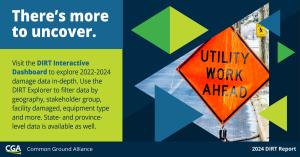CGA DIRT Report Highlights Concerning Levels of Damages to Buried Utilities, Signals Need for Industry-Wide Changes

Common Ground Alliance's 2024 DIRT Report is available at dirt.commongroundalliance.com. © 2025 by Common Ground Alliance.
Common Ground Alliance annual report underscores persistent damage root causes, late locate challenges and troubling plateau in damages despite proven solutions
The annual DIRT Report provides the most comprehensive accounting of damages to buried power, water, fiber, natural gas and other utility lines in the U.S. and Canada. This year’s report analyzed 196,977 unique damage reports from 2024, finding that despite organization-level success stories and sector-specific improvements, the industry is not on track to meet CGA’s “50-in-5” goal of reducing damages by 50% over five years.
“The 2024 DIRT Report makes it clear: Incremental change is not enough,” said CGA President and CEO Sarah K. Magruder Lyle. “We know what works—effective, balanced enforcement, accurate mapping and timely locates—but without coordinated investment and accountability across all stakeholders, damages will continue to rise alongside ever-increasing construction activity. The stakes for public safety, service reliability and economic productivity are simply too high to accept the status quo.”
Persistent Root Causes Continue to Drive Damages
The 2024 DIRT Report shows that the top 10 root causes accounted for 85% of all reported damages, with patterns remaining remarkably consistent year-over-year. Utility work — particularly water/sewer and telecommunications/CATV — dominated nine of the top ten root causes, underscoring the need for targeted, sector-specific interventions.
The leading causes were:
1. Failure to notify 811 (24.54%)
2. Excavator failed to maintain clearance after verifying marks (16.07%)
3. Facility not marked due to locator error (11.94%)
4. Marked inaccurately due to locator error (8.58%)
5. Improper excavation practice not listed elsewhere (6.75%)
6. Excavator dug prior to verifying marks by potholing (4.94%)
7. Facility not marked due to no response from operator/contract locator (4.71%)
8. Excavator failed to shore excavation/support facilities (3.27%)
9. Marks faded, lost or not maintained (2.17%)
10. Facility not marked due to incorrect facility record/map (2.16%)
“The CGA Index tells us that damages are tracking with construction activity — not with the improvements we know are possible,” said Louis Panzer, Executive Director of North Carolina 811 and Co-Chair of CGA’s Data Reporting and Evaluation Committee. “The solutions are in front of us. What’s needed now is the will to implement them at scale, across every sector and with consistent accountability.”
Late Locates Risk Undermining Confidence in the 811 System
Analysis of data from eight 811 centers revealed that excavators faced an average 38% chance of being unable to start work on time due to incomplete locate responses. States with active enforcement programs for facility operators to properly locate and provide positive responses achieved significantly higher on-time rates than those without — suggesting the challenge is solvable with the right policies.
Unpredictability of locate timing not only delays projects but can also erode excavator confidence in the 811 process, potentially contributing to the top root cause: failure to notify 811.
CGA’s Board of Directors today issued a statement highlighting the attention these findings demand. The statement, available here, reads in part:
“We call upon the industries we represent—each a critical stakeholder in damage prevention—to commit immediately to the systemic enforcement mechanisms, targeted investments and coordinated accountability measures outlined in the 2024 DIRT Report.”
Data-Driven Recommendations for Breaking Through the Plateau
The 2024 DIRT Report calls for systematic, enforceable standards and targeted sector interventions to reverse the upward damage trend, including:
• Reduce damages caused by failure to contact 811 beforehand through improved enforcement of both 811 notification requirements and locate timeliness via stronger penalties for noncompliance, “best value” locator contracts, GPS-enabled mapping and transparent on-time performance metrics.
• Targeting high-risk sectors—particularly water/sewer and telecom—with contractor training, investments in mapping improvements and contract reforms.
• Scaling proven practices from organizations that have successfully reduced damages to the industry as a whole.
• Implementing balanced enforcement that holds all stakeholders accountable, not just excavators.
• Accelerating data-driven decision-making by improving DIRT reporting quality and participation.
The complete 2024 DIRT Annual Report, along with the Interactive Dashboard featuring data from 2022-2024, is available at dirt.commongroundalliance.com.
About CGA: Common Ground Alliance is a member-driven association of nearly 4,000 damage prevention professionals spanning every facet of the underground utility industry. Established in 2000, CGA is committed to saving lives and preventing damage to North American underground infrastructure by promoting effective best practices. CGA has established itself as the preeminent source of damage prevention data and information in an effort to reduce damages to underground facilities in North America through shared responsibility among all stakeholders.
Franco Ripple
Direct Impact, Burson Group
franco.ripple@directimpact.com
Legal Disclaimer:
EIN Presswire provides this news content "as is" without warranty of any kind. We do not accept any responsibility or liability for the accuracy, content, images, videos, licenses, completeness, legality, or reliability of the information contained in this article. If you have any complaints or copyright issues related to this article, kindly contact the author above.


